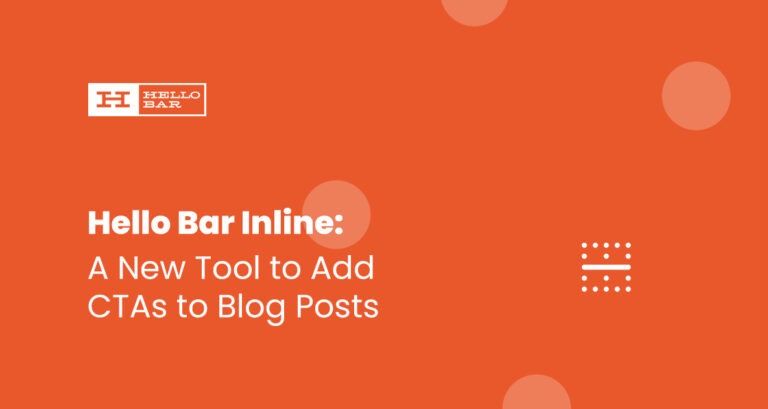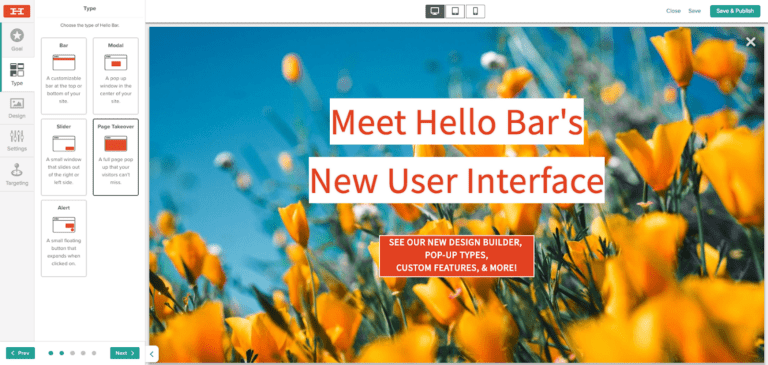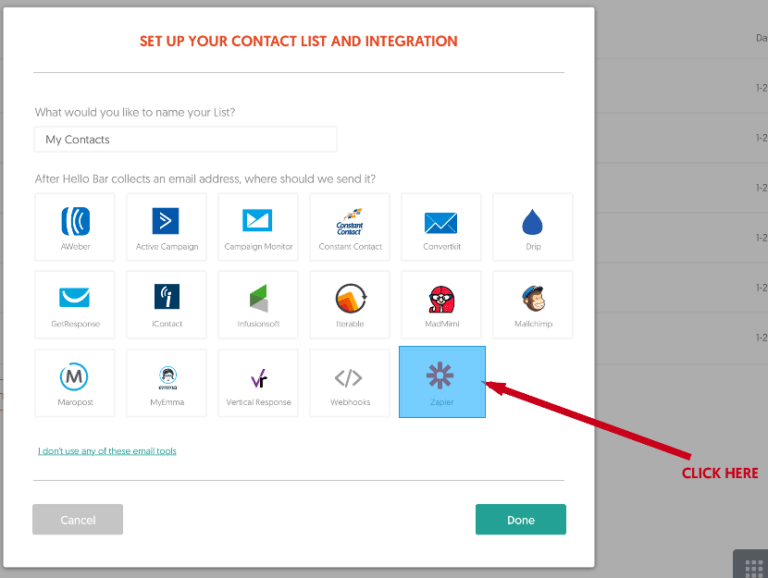How To Optimize Your Marketing Strategy Using Data From Hello Bar

I hope you enjoy this blog post. If you want Hello Bar to grow your leads, click here.
Author:
Ryan Bettencourt
Published
January 11, 2019

You’ve been asking, and we’ve delivered. Updated analytics are here!
As of our most recent update, you are now able to know all the nitty gritty details of how your pop-ups are performing. From the Analyze tab of your Hello Bar dashboard, you can now find data about how many view your pop-ups have received, how many conversions they have garnered, and you can control the exact window of time that this information is presented within!
Whether you are interested in the data from the last month, the current week, or any custom dates, you can sort your analytics to show it all!
Just having access to these new metrics isn’t enough, though. Today, I’m going to walk you through exactly how to use the data you can now access in Hello Bar in order to make the very most of your pop-ups and to truly understand the success (and future potential) of your marketing efforts.
Let’s dig in!
Why Data Backed Decisions Are Key To Your Marketing Strategies

Marketing is an interconnected field, occupying the meeting ground of almost all aspects of a business. It can feel hectic trying to decide which path to take next or which strategy to pursue – after all, digital marketing trends shift constantly and it can feel like there is a new approach every day.
You don’t have to keep up with each and every trend. Instead, focus on what is effective for your business. The best and only way to know without doubt that your marketing strategy is gaining traction is to look at your data, identify trends, and apply their findings for continued success.
A survey of 162 U.S. based senior executives found that “a whopping 64% of survey respondents ‘strongly agree’ that data-driven marketing is crucial to success in a hyper-competitive global economy.” Another 89% of brands noted that they plan to invest in predictive analytics at some point in the future to enhance their marketing efforts.
Data-driven marketing is undoubtedly the future of marketing – and in many ways, it is also the present. You’ve probably been using data-driven techniques all along. After all, as marketers we are keyed into the concept of keeping track of open rates and click through rates on emails. This concept of data-driven marketing is just an expansion of these practices.
So how do you enter into the space of using data to inform your marketing strategies and leverage the information you have in order to get the very best results? Let’s start by taking a look at the data within Hello Bar and how you can apply the data you collect within the app to your overall marketing strategy.
Getting Started With Hello Bar’s Data Analytics
![]()
If you are using Hello Bar pop-ups on your site, you are also automatically using Hello Bar to gather data on how each and every pop-up is performing – our system tracks each point of information we have in order to provide you real-time feedback on your pop-ups’ performance. (Don’t worry, your information is safe with us!).
What this really looks like in practice is a continuous tracking of how many views each of your pop-ups receives, along with how many action steps are taken in relation to it – such as someone submitting their email address, clicking through to the URL goal, or taking action on social media.
When you combine these data points to see how many visitors took action on the pop-up out of the total number of people that viewed the pop-up, you are able to arrive at your pop-up’s conversion rate.
Understanding Your Pop-Up’s Conversion Rate
Examining your pop-up’s conversion rate is the perfect place to start when it comes to using data for decision making. Afterall, you are able to gauge the success of your pop-up by reviewing this number.
Conversion rates can vary across the board, but when it comes to pop-ups, a conversion rate between 2 to 3 percent is considered to be a very healthy conversion rate.
You can find your own pop-up’s conversion rate easily by navigating to the Manage tab from your Hello Bar dashboard. It’ll look something like this:

As you can see, your pop-ups’ conversion rates are readily available. But you might not know the why behind the conversion rate – this is where further analytics come in.
How To Approach Your Hello Bar Analytics
Using our full analytics tracking in the Analyze tab of your Hello Bar dashboard, you can better track your pop-ups’ performance across time. With our latest update, you can now sort your data by time periods – whether it is by week, month, or a custom timeframe, you can view your analytics in whichever way makes the most sense to you.

As you can see, this chart depicts the performance of a set of pop-ups over the month of December 2018. There are a few things to be learned here – and I recommend viewing your own popups with the same detective approach (in your ETL pipeline) to truly understand what your data is telling you.
For starters, you’ll notice that the number of conversions trails off towards the end of the month. Right around December 22nd, there is a significant drop in conversions.
Looking at the data, this is certainly something to investigate. Any time you see a variation from the normal trend, you want to take note and think through what might be occurring.
In this case, the variation – a dip in conversions – occurs from December 22nd through December 25th. Given the proximity to the Christmas Holiday, it seems pretty evident that this dip is due to people taking time off from work to spend with their families.
Another aspect of the data that catches the eye is the periodic drop and spike that seems to happen pretty uniformly (notice those first three humps!). Matching the dates to days of the week, we see that these spikes in conversions line up with days of the work week and the dips in conversions occur during the weekend.
Just by looking at the trends in the analytics, we’ve discovered a few things – 1) our target audience is not very interested in interacting with our site during holidays, and 2) our target audience is most active during the work week.
That’s a lot more information than we started with! And we can certainly use this to inform our future marketing decisions.
For example, now that we know people aren’t nearly as active during the holidays as on other days – particularly regular days of the work week – we know that running a special holiday sale doesn’t make very much sense. We just wouldn’t have an engaged audience.
On the flipside, if we did want to make an announcement or promote a sale, we now know that weekdays are the day to do it. We can make informed decisions about when to run our best marketing efforts in order to get the very best results.
![]()
Depending on your industry, this chart might look very different. If you’re in e-Commerce, you might see a traffic spike on the weekends or around the holidays when people are eagerly spending on presents and gifts. Or, if you’re in the B2B space, you might see no traffic at all during that time.
In order to truly know what is best for your business when it comes to marketing, you will need to take a look at your analytics and contemplate the reasons behind any peaks or valleys in the data. For example, did you run a specific ad campaign at around the same time that you got a ton of new conversions on Hello Bar? Or maybe your site crashed for a day and that was associated with a decline in results.
Keeping track of all these events, then looking to see how they impacted your pop-ups’ performance, will be your golden ticket to success on Hello Bar. Take a look at your analytics now!





